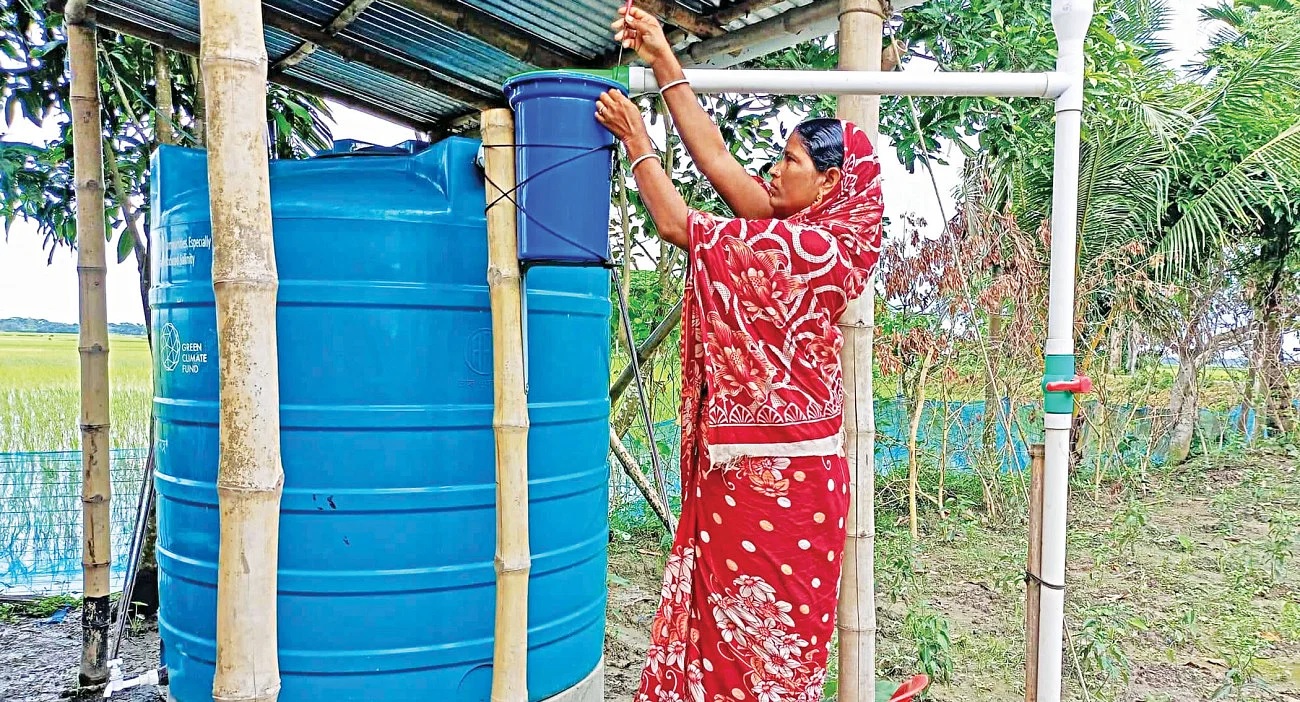Rainwater harvesting systems provided relief to families, especially mothers responsible for fetching water, allowing them to collect enough water during the rainy season to last through the dry seasons.
Water harvesting in coastal upazilas: From scarcity to security.
March 23, 2023

The Story was first published in The Daily Star Click here to read the original publication.
Archana Rani, 36, a homemaker from coastal upazila Assasuni in Satkhira, struggled for 23 years to collect drinking water from faraway sources that were often salty and contaminated with arsenic.
Initially, Archana used to walk an hour to a neighbouring village to collect water, sometimes multiple trips per day. Even when fetching water from her village, she had to walk half an hour and wait in long queues, paying Tk 6 for a pitcher of water.
This strenuous task caused her back pain which worsened during her periods. During her pregnancy, she had to carry the water alone as her husband was often away for work.
Fortunately, UNDP's Gender-responsive Coastal Adaptation (GCA) project, with financial assistance from the Green Climate Fund (GCF) and the government, helped 13,308 households in Khulna and Satkhira districts harvest rainwater using a 2,000-litre tank.

Rainwater harvesting systems provided relief to families, especially mothers responsible for fetching water, allowing them to collect enough water during the rainy season to last through the dry seasons. "The system is simple yet effective," said Mainul Islam, GCA's water and sanitation specialist at UNDP.
"We installed a 60 square feet tin roof as a self-catchment system to collect rainwater in every house. The water passes through a primary filtration system to remove larger particles, followed by a pre-filtration unit to remove solid substances and microorganisms."
Mainul also mentioned that around 20,000 households will receive drinking water from 288 community water facilities provided by DPHE. Among them, 25 facilities have been handed over to communities, and work continues in another 210 sites. The remaining 53 sites are expected to be completed by 2024.
Archana said last week's rain helped her harvest 800 litres of water, which they can use for the next few months. "We hope to collect sufficient water by the end of the season if there is enough rainfall."
Sunita Rani Sarker from Khulna's Paikgachha had a similar story. "Collecting drinking water was a struggle for 18 years, even during painful periods, pregnancy, and recovering from a caesarean delivery. Now, I don't have to spend money on water and can contribute to my family by working in others' fields," she said.
The project team conducts quality checks every three months and provides timely repairs if needed. It also created employment opportunities for 101 women, trained to install and maintain rainwater harvesting systems, known as "Pani Apas" in these areas.
Parbati Gain, a widow from Assasuni, is one such Pani Apa who regularly cleans the catchment, gutter, and filter of 301 households in ward 9 of Khajra union.
"Each household pays me Tk 20 for my services, which helps me support myself and my son," said Parbati.
A survey conducted by the GCA Project in February 2021 found that 63 percent of the population, faced difficulties in accessing drinking water, with the water crisis lasting for more than six months for 51 percent of the population.
GCA Project tested 666 tube wells and found only 27 percent of them met Bangladesh's salinity standard, while for ponds, it was 48 percent. Women in 74 percent of households were responsible for getting drinking water, reflecting the burden of unpaid work.
Households in the project area spent much more on the water than city consumers, with an average of Tk 642 or Tk 842 per month, compared to the average monthly cost of Tk 200 for all-purpose water supply in cities. The project aims to provide safe drinking water solutions to 31,000 households through six options.

 Locations
Locations


